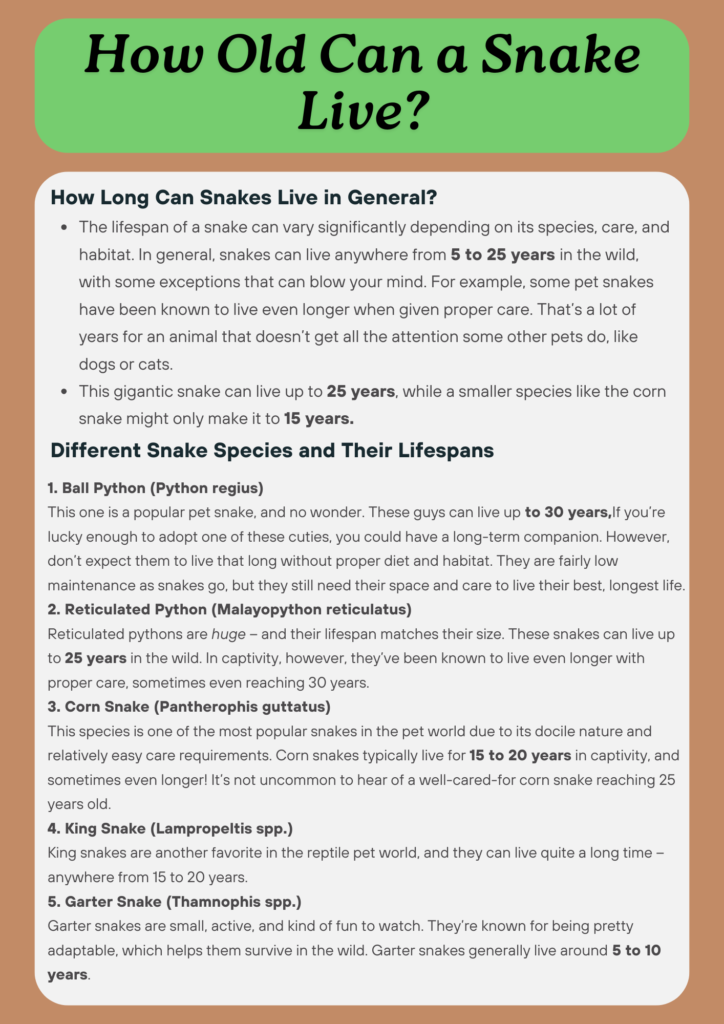When we think of snakes, we often think of their slithering, hissing ways, but did you know that these creatures can live for quite a long time? Yeah, a lot longer than we usually expect. Whether you’ve got a pet snake or just enjoy learning about them, it’s fascinating to know just how old they can get.
There are several factors that determine how long a snake can live, and it’s not just about the species – though that does play a big role. The environment, diet, and even their general care can make a huge difference in how many years a snake spends slithering around the Earth.
In this article, we’re going to dive into all the factors that contribute to their lifespan and how old some species of snakes can actually get!
How Long Can Snakes Live in General?
So, let’s start with the basics. The lifespan of a snake can vary significantly depending on its species, care, and habitat. In general, snakes can live anywhere from 5 to 25 years in the wild, with some exceptions that can blow your mind. For example, some pet snakes have been known to live even longer when given proper care. That’s a lot of years for an animal that doesn’t get all the attention some other pets do, like dogs or cats.
But, yeah, like I said, snakes come in all shapes and sizes, and each species has its own life expectancy. Larger snakes tend to live longer than smaller ones, which is pretty wild, right? Take the reticulated python, for instance. This gigantic snake can live up to 25 years, while a smaller species like the corn snake might only make it to 15 years. But here’s the thing—some pet snakes can live beyond their expected life span if they’re well taken care of!

Different Snake Species and Their Lifespans
Ok, let’s break this down by species. A lot of people think snakes only live a couple of years, but in reality, some of these guys live forever (well, not forever, but you get what I mean).
1. Ball Python (Python regius)
Ah, the ball python! This one is a popular pet snake, and no wonder. These guys can live up to 30 years with the right care! That’s right, 30 years. If you’re lucky enough to adopt one of these cuties, you could have a long-term companion. However, don’t expect them to live that long without proper diet and habitat. They are fairly low maintenance as snakes go, but they still need their space and care to live their best, longest life.
2. Reticulated Python (Malayopython reticulatus)
Reticulated pythons are huge – and their lifespan matches their size. These snakes can live up to 25 years in the wild. In captivity, however, they’ve been known to live even longer with proper care, sometimes even reaching 30 years. But, and this is a big but, they need a ton of space, and not just space but also the right diet and environment. So if you’re considering getting one of these giant snakes, know that they come with a serious commitment.
3. Corn Snake (Pantherophis guttatus)
Now, let’s talk about the corn snake. This species is one of the most popular snakes in the pet world due to its docile nature and relatively easy care requirements. Corn snakes typically live for 15 to 20 years in captivity, and sometimes even longer! It’s not uncommon to hear of a well-cared-for corn snake reaching 25 years old. So, if you’re thinking of adopting one, you could be in for a long-lasting companion.
4. King Snake (Lampropeltis spp.)
King snakes are another favorite in the reptile pet world, and they can live quite a long time – anywhere from 15 to 20 years. They’re pretty hardy snakes, but, again, diet and environment matter. With proper care, a king snake could live to be 20 years old, or more. Their lifespan can be shorter in the wild because of predators, habitat loss, and other environmental factors, but in captivity, they can have a pretty decent run.
5. Garter Snake (Thamnophis spp.)
Garter snakes are small, active, and kind of fun to watch. They’re known for being pretty adaptable, which helps them survive in the wild. Garter snakes generally live around 5 to 10 years. If you’re lucky and they’re well taken care of, though, they might live a little longer. In captivity, the average lifespan tends to be a bit longer than in the wild, where dangers like predators and habitat loss can take their toll.
What Affects a Snake’s Lifespan?
Okay, so now that we know how long different snakes can live, let’s talk about what actually affects their lifespan. Spoiler alert: It’s not all about luck!
1. Diet and Nutrition
Just like any other animal, the quality of a snake’s diet has a huge impact on its lifespan. Snakes in the wild tend to eat a diet of small rodents, birds, and sometimes even amphibians, depending on the species. If you have a pet snake, it’s important to mimic their natural diet as closely as possible. Malnourishment or an imbalanced diet can shorten their life expectancy.
2. Habitat and Enclosure Size
Another big factor is habitat. A cramped or improperly maintained enclosure can stress your snake out and cause health issues. Snakes need the right amount of heat, humidity, and space to thrive. If these factors aren’t met, they may not live as long as they could in a better environment.
3. Healthcare and Veterinary Care
Yes, snakes need healthcare too! Regular check-ups with a reptile vet are essential for keeping them healthy. Over time, illnesses can develop that may not be immediately visible. If left untreated, this could lead to a shorter lifespan.
4. Stress Levels
Snakes can get stressed, just like humans, and stress can shorten their life expectancy. Constant handling, loud noises, or a messy enclosure can all contribute to a stressed-out snake. If they’re too stressed, it can lead to issues like loss of appetite, weight loss, and even premature death.
Conclusion
So, how old can a snake live? Well, it depends on the species, the care you provide, and a bunch of other factors. Some snakes can live for only a few years, while others can stick around for decades, especially when they’re cared for properly. Whether you’re thinking about getting a pet snake or just curious about their lifespan, it’s clear that these fascinating creatures have quite a bit of longevity in them—if everything’s just right.
So, if you’re a snake owner (or planning to be), make sure to give them the best care possible. After all, they might just stick around longer than you expect! Keep their environment cozy, their diet balanced, and their stress levels low, and you might just have a snake buddy for a long time. Happy snake-keeping!

